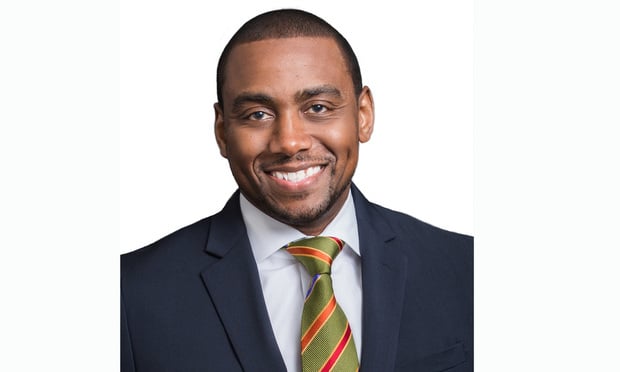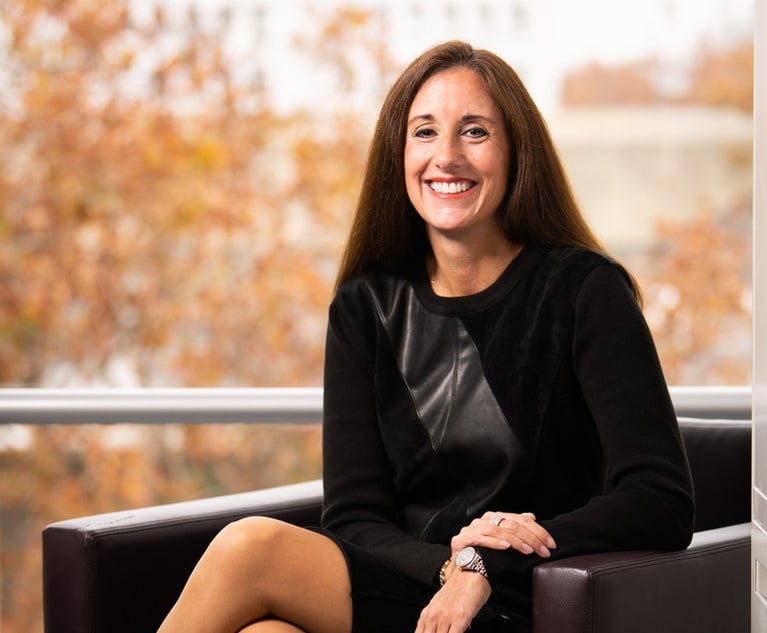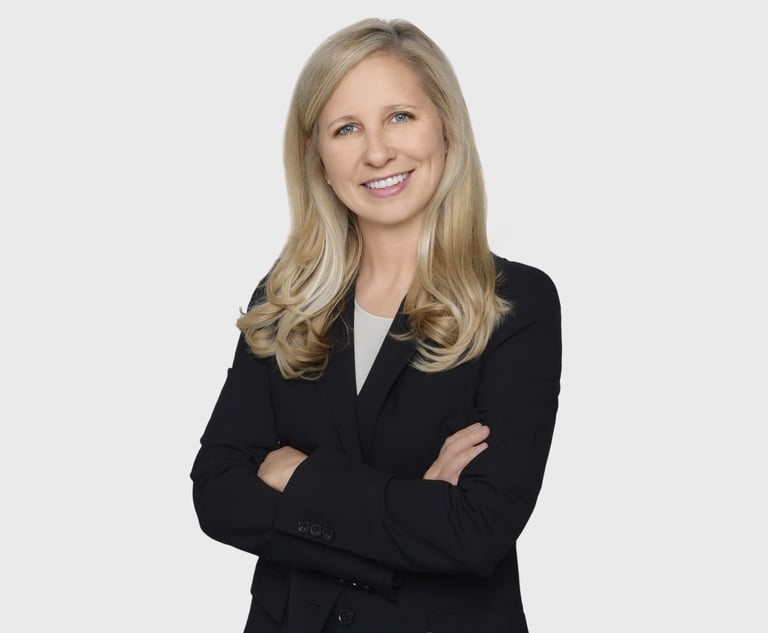Where Do We Stand Regarding Diversity Anyway?
Markowitz Ringel Trusty + Hartog partner Adrian C. Delancy offers his firm's perspective on diversity along with the conclusion that "we still have a long way to go."
June 27, 2019 at 06:00 AM
5 minute read
 Adrian Delancy, Markowitz, Ringel, Trusty & Hartog
Adrian Delancy, Markowitz, Ringel, Trusty & Hartog
In preparing to write this article I Googled “diversity in the legal profession,” and no shortage of articles popped-up.
In fact, I stopped reading after several minutes as a common theme soon emerged: there simply doesn't appear to be much of it, and there's no consensus as to what should be done about it.
This is certainly not a new topic. I recall similar questions being posed long ago as law schools and law firms grappled with issues such as affirmative action, diversity policies and strategies for building inclusive and representative legal practices.
Because we are a nation of laws, our society functions best when law firms, like the justice system in general, adequately and proportionately reflect the people who comprise it.
When we look beneath the surface, it seems diversity is an ideal and seldom a reality. Nearly every website boasts its firm's unflinching commitment to diversity. The numbers, however, tell a different story. Numerous articles chronicle the lagging numbers of minority and women attorneys and partners in relation to the prevailing demographics.
Much like Dr. Martin Luther King Jr.'s dream for America, diversity in the legal profession is a perpetual work-in-progress: “we've come a long way, but still have a long way to go.” Sound familiar?
This brings me to the point of introspection. How has my firm, where I've practiced law for the past 12 years, handled diversity? The numbers break down as follows:
- Out of a total of 15 attorneys, 7 are women, 4 are Hispanic, 2 are Asian and 1 is African American;
- Out of 7 total partners, 2 are women (including a Korean female) and 1 is an African American male;
- Out of 4 shareholder/equity partners, 1 is female;
- Of our 15 attorneys, eight, or 53%, are women and minorities.
Perhaps our commitment to diversity is best summed up by this statement which is part of our diversity policy: “We refuse to be defined as just another law firm because we are more than that. The firm's logo — anchored by a large plus sign — exemplifies this view by reminding us that we are never just one thing and that we always can — and will — do more. We are lawyers + community advocates. We are professionals + family members. We are teachers + students.
These roles shape us and provide us the ability to be more than just attorneys with a singular perspective. Above all, we are professionals with a broad spectrum of knowledge, experience and beliefs from which we draw to serve our clients.
Having been in business for almost 40 years, our founding shareholders feel that the easiest way to ensure a diverse and inclusive law firm is to incorporate the shared experiences of each of its members into a unified firm culture.
Our strength is our diversity because having a diverse staff and attorneys allows us to better understand the needs of our clients and provide more effective representation to all, and not just some, South Florida communities.
Shareholder Jerry Markowitz and his family lived a life of diversity and inclusion long before such policies appeared on the firm's website. Family photographs in the office tell the story of a time when Jerry's parents, Harry and Florence Markowitz, owned and operated the historic Hampton House Motel & Villas in what is now the Brownsville neighborhood of Miami.
Because of segregation in the 1960s and 1970s, famous black entertainers, politicians, athletes and other luminaries could only stay in black neighborhoods when they visited Miami and Miami Beach. The Hampton House was a refuge for greats such as Martin Luther King Jr., Muhammad Ali, Malcolm X, Nat King Cole, Marvin Gaye, Jackie Robinson, Joe Louis and Althea Gibson.
This left an indelible mark on young Jerry that helped to shape his vision for the firm. Similarly, shareholder Tom Ringel grew up in a small Ohio town where he vividly remembers the Ku Klux Klan gathering in the center of town in full regalia to protest the showing of the 1967 film “Guess Who's Coming to Dinner” featuring an interracial couple.
These combined experiences led to the firm's broader commitment to the South Florida community, where members of the firm serve a variety of organizations, foundations and causes and give back through pro bono legal efforts.
Every law firm is different with their own set of unique experiences behind their founding. Law firms interested in incorporating diversity and inclusion into their vision should consider doing the following:
- Publish a diversity and inclusion policy that the firm is committed to and communicate the policy to all stakeholders
- Create a diversity and inclusion committee that consists of management, attorneys and hiring staff.
- Identify career paths for minority attorneys and pair them with mentors.
- Establish minority affinity groups as needed and seek their feedback.
While there is no magic recipe or one right way of improving diversity and inclusion in the legal industry, it is clear our life experiences invariably shape our business choices and management styles.
For us, a dedication to the principles of inclusion and the integration of diverse experiences has defined our firm culture. But like most firms, we can and should do better. And we understand that what works here, may not work at other firms.
Nevertheless, the legal industry must remain dedicated to obtaining concrete, demonstrable results in numbers. To this I can only say: although we've come a long way, we still have a long way to go.
Adrian C. Delancy is a partner with the Miami law firm of Markowitz Ringel Trusty + Hartog and concentrates his practice in bankruptcy and commercial litigation. Contact him at [email protected]
This content has been archived. It is available through our partners, LexisNexis® and Bloomberg Law.
To view this content, please continue to their sites.
Not a Lexis Subscriber?
Subscribe Now
Not a Bloomberg Law Subscriber?
Subscribe Now
NOT FOR REPRINT
© 2025 ALM Global, LLC, All Rights Reserved. Request academic re-use from www.copyright.com. All other uses, submit a request to [email protected]. For more information visit Asset & Logo Licensing.
You Might Like
View All
EB-5 Rebounds After a Rocky Year: Challenges of 2024 Lay Groundwork for a Booming 2025

Greenberg Traurig, Holland & Knight Leaders Expect AI Investments to Jump in 2025
5 minute read
Leveraging the Power of Local Chambers of Commerce: A Second-Career Lawyer’s Guide to Building a Thriving Practice
5 minute readTrending Stories
- 1Relaxing Penalties on Discovery Noncompliance Allows Criminal Cases to Get Decided on Merit
- 2Reviewing Judge Merchan's Unconditional Discharge
- 3With New Civil Jury Selection Rule, Litigants Should Carefully Weigh Waiver Risks
- 4Young Lawyers Become Old(er) Lawyers
- 5Caught In the In Between: A Legal Roadmap for the Sandwich Generation
Who Got The Work
J. Brugh Lower of Gibbons has entered an appearance for industrial equipment supplier Devco Corporation in a pending trademark infringement lawsuit. The suit, accusing the defendant of selling knock-off Graco products, was filed Dec. 18 in New Jersey District Court by Rivkin Radler on behalf of Graco Inc. and Graco Minnesota. The case, assigned to U.S. District Judge Zahid N. Quraishi, is 3:24-cv-11294, Graco Inc. et al v. Devco Corporation.
Who Got The Work
Rebecca Maller-Stein and Kent A. Yalowitz of Arnold & Porter Kaye Scholer have entered their appearances for Hanaco Venture Capital and its executives, Lior Prosor and David Frankel, in a pending securities lawsuit. The action, filed on Dec. 24 in New York Southern District Court by Zell, Aron & Co. on behalf of Goldeneye Advisors, accuses the defendants of negligently and fraudulently managing the plaintiff's $1 million investment. The case, assigned to U.S. District Judge Vernon S. Broderick, is 1:24-cv-09918, Goldeneye Advisors, LLC v. Hanaco Venture Capital, Ltd. et al.
Who Got The Work
Attorneys from A&O Shearman has stepped in as defense counsel for Toronto-Dominion Bank and other defendants in a pending securities class action. The suit, filed Dec. 11 in New York Southern District Court by Bleichmar Fonti & Auld, accuses the defendants of concealing the bank's 'pervasive' deficiencies in regards to its compliance with the Bank Secrecy Act and the quality of its anti-money laundering controls. The case, assigned to U.S. District Judge Arun Subramanian, is 1:24-cv-09445, Gonzalez v. The Toronto-Dominion Bank et al.
Who Got The Work
Crown Castle International, a Pennsylvania company providing shared communications infrastructure, has turned to Luke D. Wolf of Gordon Rees Scully Mansukhani to fend off a pending breach-of-contract lawsuit. The court action, filed Nov. 25 in Michigan Eastern District Court by Hooper Hathaway PC on behalf of The Town Residences LLC, accuses Crown Castle of failing to transfer approximately $30,000 in utility payments from T-Mobile in breach of a roof-top lease and assignment agreement. The case, assigned to U.S. District Judge Susan K. Declercq, is 2:24-cv-13131, The Town Residences LLC v. T-Mobile US, Inc. et al.
Who Got The Work
Wilfred P. Coronato and Daniel M. Schwartz of McCarter & English have stepped in as defense counsel to Electrolux Home Products Inc. in a pending product liability lawsuit. The court action, filed Nov. 26 in New York Eastern District Court by Poulos Lopiccolo PC and Nagel Rice LLP on behalf of David Stern, alleges that the defendant's refrigerators’ drawers and shelving repeatedly break and fall apart within months after purchase. The case, assigned to U.S. District Judge Joan M. Azrack, is 2:24-cv-08204, Stern v. Electrolux Home Products, Inc.
Featured Firms
Law Offices of Gary Martin Hays & Associates, P.C.
(470) 294-1674
Law Offices of Mark E. Salomone
(857) 444-6468
Smith & Hassler
(713) 739-1250







